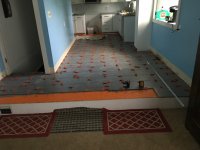Packard
Member
I am looking at some 12" x 24" slate-look ceramic tile for a bathroom. It does not say if it is porcelain or ceramic. The tiles have rectified edges, a look I prefer.
It does say this about overlap and I have no idea what it means. I've tiled just one bathroom in the past and it turned out fine. But I am far from an expert at this.
Overlap during installation should not exceed 33%, 50% overlap not recommended
https://www.homedepot.com/p/Traffic...case-CR081224HD1PV/303517940#product-overview
Can someone tell me that that means? The other tile I installed was 12" x 12". Will this create any special difficulties? I did buy one piece and check to see if my tile cutter could cut it and it worked just fine in the 24" direction. I don't see an issue in cutting it in the 12" direction.
It does say this about overlap and I have no idea what it means. I've tiled just one bathroom in the past and it turned out fine. But I am far from an expert at this.
Overlap during installation should not exceed 33%, 50% overlap not recommended
https://www.homedepot.com/p/Traffic...case-CR081224HD1PV/303517940#product-overview
Can someone tell me that that means? The other tile I installed was 12" x 12". Will this create any special difficulties? I did buy one piece and check to see if my tile cutter could cut it and it worked just fine in the 24" direction. I don't see an issue in cutting it in the 12" direction.



